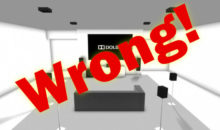What is Dolby Volume?
Many people have asked me of late: What is Dolby Volume? Well, have you ever watched television and then experienced the ear-bleeding volume associated with a commercial that was mastered at extremely high levels? If so, you are the perfect candidate for Dolby Volume.
Commercials Not the Only Reason for Using Dolby Volume
And while commercials are a major culprit, they aren’t the only problem with watching television. Just jumping from a news channel to a movie, or over to a different source like a gaming system or a networked streaming media device can result in greatly mismatched volume levels. Of course, you can certainly use the remote and adjust the volume on the fly. However, Dolby Volume provides a new way of solving this ever-increasingly common problem.
How Dolby Volume Works
The way Dolby Volume works is that you set the initial volume, and the system does the rest. A receiver, television, or set-top box equipped with Dolby Volume will take the stereo or multi-channel audio that it has and conform it to that initial selected volume level. But it does more than just level the volume. It also takes into account what that volume is and what to do with things like dialogue, surround effects, and background ambiance when played back at lower sound levels.
If you’ve ever played back a movie at low volume and wondered why you didn’t hear anything in the surrounds, you’ll appreciate the work Dolby Volume technology does. It attempts to restore the intended effects of the mix engineer or re-recording mixer. These folks mastered the original soundtrack or piece of music at reference levels. Dolby Volume restores this mix when played back at less-than-reference volume.
You Actually Hear More
Dolby Volume helps you eliminate the hassle of getting blown out of your seat by an ad for prescription drugs. You also benefit by hearing more of the sounds you would otherwise have missed if you dropped the playback volume on a movie. Picture the benefits when you watch movies at night while the kids are asleep. It’s pretty impressive, too. It uses some fancy algorithms to analyze each individual audio track. It then brings back items that would otherwise be completely buried in the mix.
The result is surround sound at low volumes. It also restores low frequencies and dynamic sound effects that you would otherwise simply not hear. The result is natural and as close to the original as possible. In fact, it actually sounds more like the original than the untouched track does when played back at low levels.
Dolby Volume Features include:
- Monitoring of discrete frequencies and their content
- Adjustment of perceived loudness in up to 40 frequency bands
- Advanced digital signal processing based on perceptual human hearing
- Completely transparent operation, with no audible side effects or artifacts
- Sound leveling plus low volume mix restoration
- Effective in mono, stereo, or surround sound
Dolby Volume vs Loudness Controls
As you probably know, adjusting volume is only part of the problem when listening at low levels. Years ago (even on some products sold today) a feature existed called a “loudness control”. It provided a contour that increased bass and treble frequencies. This helped compensate for what drops out when you listen at lower volumes. But these basic EQ curves aren’t sufficient to really restore the nuances of a surround sound mix when listening to movies or music.
Human hearing simply has less sensitive to both bass and treble at lower volumes. But, in addition to that, our ability to differentiate detail also decreases. If you just boost low and high frequencies, you end up with a muddy sound that doesn’t do anything to restore the details lost in a soundtrack that is played back at less-than-reference volume. And boosting just the surround speakers does nothing to help you restore the intended mix, either—it just gives you more emphasis on surrounds.
Dolby Volume attempts to deal with the intricacies of a surround mix by employing sophisticated algorithms to differentiate multiple frequency bands in each of the 6 to 8-channels of a surround mix. It monitors these discrete frequencies and adjusts the perceived volume in up to 40 different frequency bands. It also doesn’t automatically deploy its DSP algorithms, but only uses them on an as-needed basis to keep as much as the original soundtrack unmolested. The result is a more natural listening experience—one that isn’t fraught with muddy aftereffects of sloppy EQ.
Conclusion
The bottom line here is that everyone can use Dolby Volume because everyone suffers from the same inherent difficulties in television and movie-watching. Commercials are compressed and in-your-face with respect to volume, and movies are mixed for reference levels and often played back in rooms where you can’t get them loud enough to hear everything as the mixer intended. Dolby Volume aims to restore the listening experience to as close to the intended mix as possible. So far, we’ve been very impressed.
Do you have and use Dolby Volume in your home theater? Why or why not? Our Facebook page is a great place to drop us a note and you can also leave a comment on this article letting us know what you think.







So what ever happened to Dolby Volume? How do I add it to my system? What preamp/processors have/had it?